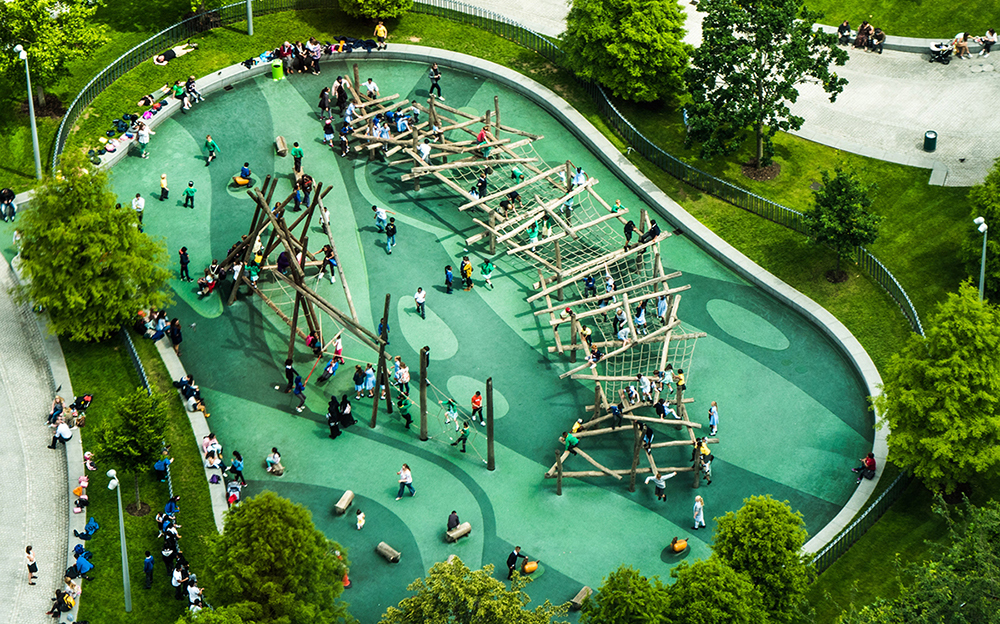As our next contributor, we are honoured to introduce Ms. Sarah Scheiber to the Green Deal Malta platform. In her article, Sarah speaks about urban open spaces and Green Infrastructure (‘GI’) planning, as well as tying these in with the objectives of the European Green Deal. Sarah explains what Green Infrastructure really means, and notes that locally, the idea of GI is becoming more popular. Sarah explains that there is the need to move beyond individual elements such as green roofs or green walls and think in terms of more holistic and integrated approaches. We need to think of the multi-functionality and connectivity of Green Infrastructure, and plan proactively for the development of green and blue open space networks to create GI systems. Have a look at Sarah’s article to find out more!
Locally, the idea of Green Infrastructure (GI) is becoming more popular. More often than not, this is used in the context of interventions such as green roofs, green walls, or ‘greening’ in the form of planting new trees. However, what does the term green infrastructure really mean, and how can GI contribute to achieving the objectives of the European Green Deal?
At a European level, Green Infrastructure has been defined as “a strategically planned network of natural and semi-natural areas with other environmental features designed and managed to deliver a wide range of ecosystem services”. [1] The concept of ‘urban green infrastructure’ planning can be defined as a “strategic planning approach that aims to develop networks of green and blue spaces in urban areas, designed and managed to deliver a wide range of ecosystem services and other benefits at all spatial scales.” [2]
The concept of planning for GI differs from other open space planning models, because it attempts to integrate ecological and social values together with other land use values. It tries to propose a way for understanding the connection between ecosystem services and human wellbeing [3]. Finally, Green Infrastructure is seen as one of the more effective contemporary planning approaches in working towards sustainable and resilient urban areas, [3] [4] [5] since it has the potential to mitigate a number of urban challenges [2]. If urban open spaces could therefore function as GI, they would have the potential to contribute towards sustainable development and increase the resilience of our towns and cities.
“There is the need to move beyond individual elements such as green roofs or green walls and think in terms of more holistic and integrated approaches.”
To do this however, there is the need to move beyond individual elements such as green roofs or green walls, and think in terms of holistic and integrated approaches. What does this mean? It means that we need to think of the multi-functionality and connectivity of Green Infrastructure. That is, we need to plan proactively for the development of green and blue open space networks to create Green Infrastructure systems.
Acknowledging that individual open spaces are also actually nodes within a network of inter-connected spaces, the concepts of hierarchies and connectivity come into play. Hierarchies refer to the different types of open spaces which may exist, ranging from parks and urban squares, to streets, incidental urban places and even car parks. When planning and designing an open space, it is important to consider how these form part of such a network and how one relates to another. In this sense, each space would then perform different functions and contribute in varying ways accordingly [6].
In parallel, the connectivity of urban open spaces is equally important to maximise value. This could concern urban climate, providing support to habitats and biodiversity, or sustainable water management. Sustainable movement within urban areas is also dependent on this characteristic. Connected spaces are also important in terms of structuring the urban environment to ensure legibility and a sense of orientation. Additionally, if connectivity extends to the wider landscape, the possibility exists to strengthen the meanings and values present in urban spaces [6].
The European Green Deal is Europe’s plan to make the EU’s economy sustainable by “turning climate and environmental challenges into opportunities, and making the transition just and inclusive for all”. [7] Amongst other things, it talks about the need to protect our ecosystems and restore biodiversity, ensure more sustainable food systems, promote sustainable means of transport, cut pollution rapidly, reduce greenhouse gas emissions, use resources such as water more efficiently, and adapt to the impacts of climate change.
The question is, how can the open spaces in our urban areas, function as GI so as to achieve such objectives?
Attractive urban spaces influence residents’ decisions to spend their free time within an urban area, or travel to more attractive areas outside of the urban area. This has an impact on traffic and the movement of people to reside outside the urban areas where they work, thereby further generating commuter traffic. This not only has an impact on quality of life due to increased time used for travelling, but also on public health aspects due to decreased air quality resulting from increased traffic.
From a climatic perspective, the micro-climate in cities is being undermined by the urban heat island effect. This is when temperatures rise due to heat being given out by heating systems in buildings, or heat absorbed by surfaces. Combine this with a lack of vegetation which could provide cooling benefits, and urban micro-climates tend to be more uncomfortable than rural ones. The presence of vegetation in open spaces can also support a variety of ecosystem services by providing habitats for plants or animals, as well as mitigating the impacts of noise and air pollution.
Additionally, if planned and designed as Green Infrastructure, open spaces can allow for infiltration of rainwater which can help to reduce loads on storm water drainage systems, thus increasing their resilience and flexibility. This can help in mitigating increased flooding in urban areas, as well as contribute to ground water recharge where suitable.
The design of urban open spaces is also important in relation to sustainable mobility. Some principles of Sustainable Urban Mobility Plans (SUMPS) are car use regulation in urban centres, traffic calming, promotion of cycling and pedestrian modes, and integration of transport modes/different road users. All these principles present themselves in the design and allocation of space in our urban areas [8] [9].
Looking forward, there is the opportunity for Green Infrastructure planning principles to form an integral part of the review of the Strategic Plan for Environment and Development (SPED) and other Local Plans.
The importance of the design of ´Streets for People´ or ´Streets as Places´ dates back to the 1960s in the work of Jane Jacobs, [10] where she outlined the crucial qualities of streets for successful urban neighbourhoods. Getting people out of their cars requires creating urban places and spaces that delight, that bring people in contact with one another, and with interesting objects, events, and environments. It is hard to overstate the value and importance of streets that are designed for people, for pedestrians. Providing for physical exercise, opportunities to socialize, connections to places and nature, enjoyment and fun, and walking are all essential elements of a sustainable and resilient city.
Finally, to capitalise on potential benefits, when planning for urban Green Infrastructure, there are some key principles [2] that need to be considered. These are:
- Grey-green Integration, meaning the coordination of urban green spaces with other infrastructure such as transport systems and utilities.
- Connectivity, which involves creating and restoring connections to support and protect processes, functions and benefits that individual green spaces cannot provide alone.
- Multi-functionality, that is, combining different functions so as to enhance the capacity of urban green spaces to deliver multiple benefits.
- Social Inclusion which aims for collaborative, socially inclusive processes so as to incorporate the knowledge and needs of diverse parties.
Research [11] has shown that there is the potential for the planning system in Malta to integrate such principles in its processes and policies if we really want to work towards sustainable and resilient urban areas. Adopting a Green Infrastructure planning approach could be a way to do this. A review of the Strategic Plan for Environment and Development (SPED) and Local Plans has been launched. Looking forward, there is the opportunity for Green Infrastructure planning principles to form an integral part of this review. This is essential, if we really want to capitalise on the benefits of Green Infrastructure, so that as a country, we can move towards achieving the Green Deal objectives.
References
- European Commission. (2019). Environment: Ecosystem services and Green Infrastructure. Retrieved November 06, 2020, from European Commission: https://ec.europa.eu/environment/nature/ecosystems/index_en.htm
- Hansen, R., Rall, E., Chapman, E., Rolf, W., & Pauleit, S. (2017). Urban Green Infrastructure Planning: A Guide for Practitioners. GREEN SURGE. Retrieved November 10, 2020, from https://www.e-pages.dk/ku/1340/html5/
- Lafortezza, R., Davies, C., Sanesi, G., & Konijnendijk, C. C. (2013). Green Infrastructure as a tool to support spatial planning in European urban regions. iForest – Biogeosciences and Forestry, e1-e7.
- Schiappacasse, P., & Muller, B. (2015). Planning Green Infrastructure as a Source of Urban and regional Resilience – Towards Institutional Challanges. Urbani Izziv.
- Pauleit, S., Ambrose-Oji, B., Andersson, E., Anton, B., Buijs, A., Haase, D., . . . P.N., A. (2018). Advancing Urban Green Infrastructure in Europe: outcomes and reflections from the Green Surge project. Urban Forestry and Urban Greening.
- Stiles, R. (2009). A Guideline For Making Space: Joint Strategy Activity 3.3. Retrieved from UrbSpace.
- European Commission. (n.d.) A European Green Deal: Striving to be the first climate-neutral continent. Retrieved May 27th, 2021, from European Commission.
- European Commission. (2013). Communication from the Commission to the European Parliament, The Council The European Economic and social Committee and the Committee of the Regions: Together towards competitive and resource-efficient urban mobility. European Commission.
- Rupprecht Consult. (2014). Guidelines, Developing and implementing a sustainable urban mobility plan. Retrieved March 29, 2015, from Eltis The urban mobility observatory: http://www.eltis.org/sites/eltis/files/sump_guidelines_en.pdf
- Jacobs, J. (1961). The Death and Life of Great American Cities. United States: Random House.
- Scheiber, S. (2021) Urban Open Spaces and their Potential as Green Infrastructure: Towards and Integrated Approach for a Sustainable Built Environment in Malta. Phd Thesis. University of Malta, Submitted for Review.
Contributor(s)

Sarah Scheiber
Sarah Scheiber is specialised in urban design and spatial planning and is a lecturer within the Faculty for the Built Environment at the University of Malta. She has recently completed her PhD research on the planning and design of urban open spaces in Malta. The research looks at the potential for urban open spaces in Malta to contribute to the sustainable development of the built environment. In particular, it looks at the adoption of an ‘Urban Green Infrastructure Planning Approach’. After reading for her Masters, which specialised in the renewal and redesign of city areas, at the Technical University of Delft, The Netherlands, Sarah spent several years working as an urban designer in both private and public spheres in The Netherlands and the United Kingdom. Sarah is passionate about improving the quality of the urban environment and is co-founder of the platform 'Dawra Madwarna: Connecting People, Connecting Places', an organisation set up to create a network of interdisciplinary professionals working to contribute to the transformation of public spaces within Malta’s urban areas for a more sustainable future.






